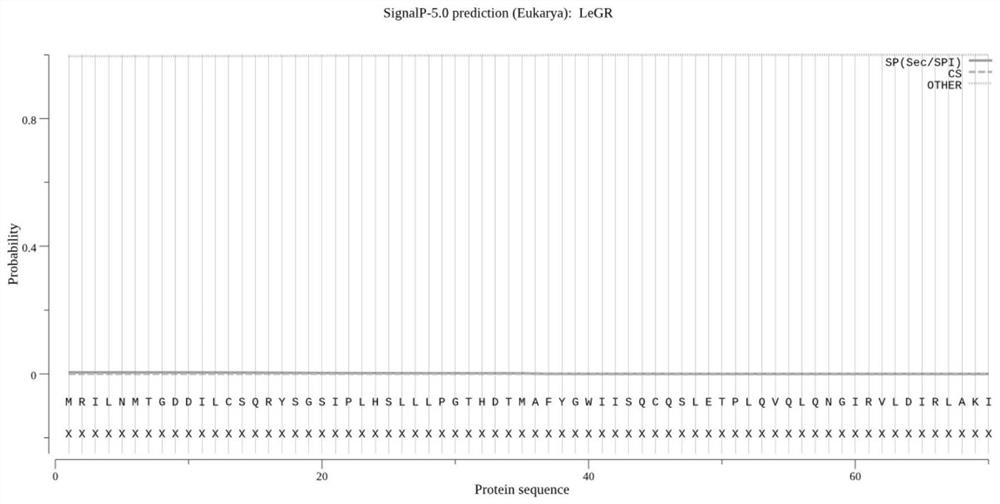Application of lentinus edodes glutathione reductase LeGR in improving temperature stress resistance of microorganism
A glutathione and reductase technology, applied in microorganism-based methods, microorganisms, oxidoreductases, etc., can solve the problem of glutathione reductase not seen in mushrooms, and improve cold stress tolerance and heat stress. ability, the effect of improving the ability to withstand temperature stress
- Summary
- Abstract
- Description
- Claims
- Application Information
AI Technical Summary
Problems solved by technology
Method used
Image
Examples
Embodiment 1
[0046] Construction of glutathione reductase LeGR overexpression vector pET30a / LeGR in Example 1 Lentinus edodes 18
[0047] First, design primers to amplify the LeGR fragment of the target gene from the original plasmid, and then recombine it into the digested overexpression vector pET30a through the seamless cloning recognition sites at both ends of the primer; transfer the ligated product into the prepared The competent cells of Escherichia coli LB21 were sent to Beijing Qingke Biotechnology Co., Ltd. for sequencing and identification of the grown monoclonal colonies. The correct clone sequence was the successful construction of the overexpression plasmid pET30a / LeGR, and the map was successfully constructed. Such as Figure 5 shown.
[0048] 1. Design and synthesize primers
[0049] (1) Design PCR amplification fragment primers, and introduce homologous sequences at the ends of the linearized cloning vector at the 5' end of the primers, so that the 5' and 3' end sequence...
Embodiment 2
[0085] Prokaryotic expression of embodiment 2 Lentinus edodes LeGR gene
[0086] 1. Inoculate a single colony of Escherichia coli LB21 containing pET30a / LeGR in 100mL LB liquid medium containing 100μg / mL Kan, culture at 220rpm and 37°C until the OD600 reaches 0.6-0.8, and then add IPTG with a concentration of 1mM to In 100mL liquid LB, continue to culture at 220rpm, 37°C for 4h, in order to achieve the purpose of optimizing the induction culture conditions. At the same time, the empty vector pET30a was transformed into LB21 as a control.
[0087] 2. Extract prokaryotic expressed protein for SDS-PAGE electrophoresis
[0088] ①Protein sample preparation
[0089] (1) Take 1mL of the bacterial solution from Step 1 and add it to 100mL LB (containing 100μg / mL Kan) liquid medium, incubate at 37°C and 220r / min for 2.5-3h, and use a UV spectrophotometer to detect when the OD600 reaches 0.4-0.6 , adding IPTG with a final concentration of 1 mM for induction;
[0090] (2) After adding...
Embodiment 3
[0104] Example 3 Research on cold-resistant function of Lentinus edodes LeGR protein
[0105] 1. Take 50μL of the verified bacterial solution, inoculate it into 50mL LB (containing 100μg / mL Kan) liquid medium, incubate at 37°C and 150r / min for 2.5-3h, and detect it with a UV spectrophotometer until the OD600 reaches 0.4-0.6 , 1 mM IPTG was added for induction.
[0106] 2. Placed in an incubator at 4°C, and subjected to cold stress for 12h, 24h, 36h, 48h, 60h.
[0107] 3. Take 2 mL of the bacterial liquid after the cold stress treatment, detect the absorbance at 600 nm with an ultraviolet spectrophotometer, and record the data. Three replicates were set for each experimental gradient.
[0108] 4. Treat the absorbance of 0h bacterial liquid OD600 as a control group respectively, calculate the growth rate of Escherichia coli containing pET30a / LeGR and pET30a Escherichia coli, and make a line graph of growth rate after cold stress (note: growth rate=treatment Escherichia coli OD...
PUM
| Property | Measurement | Unit |
|---|---|---|
| molecular weight | aaaaa | aaaaa |
Abstract
Description
Claims
Application Information
 Login to View More
Login to View More - R&D
- Intellectual Property
- Life Sciences
- Materials
- Tech Scout
- Unparalleled Data Quality
- Higher Quality Content
- 60% Fewer Hallucinations
Browse by: Latest US Patents, China's latest patents, Technical Efficacy Thesaurus, Application Domain, Technology Topic, Popular Technical Reports.
© 2025 PatSnap. All rights reserved.Legal|Privacy policy|Modern Slavery Act Transparency Statement|Sitemap|About US| Contact US: help@patsnap.com



